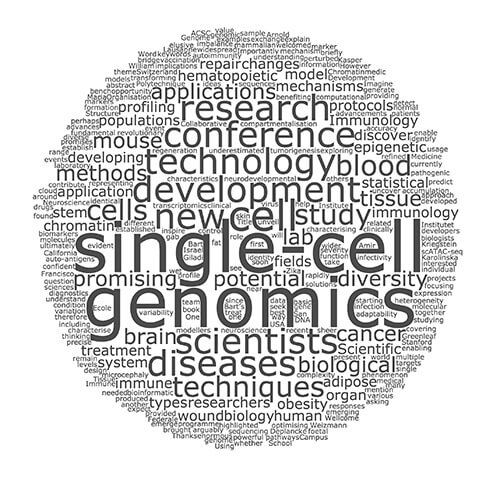In September 2016, Advanced Courses and Scientific Conferences welcomed scientists from across the world to their Single Cell Genomics conference at the Wellcome Genome Campus. This event brought together a range of researchers: biologists, methods developers, computational modellers and genomics researchers all interested in understanding biological variation at the single-cell level.
Single cell genomics is rapidly emerging as a revolutionary technology transforming many fields of biological research, including immunology and cancer. Scientists can now profile the genomic characteristics of cells at individual level.
Below is a summary of some of the highlights of the conference, and examples of research projects that were presented.
The conference was diverse, covering neuroscience, tissue development, immunology, and cancer, among others:

Immunology
Immunology is one of the fields benefiting the most by using SCG to discover the enormous diversity of immune cells. Immune cell profiling can be used to study cell responses to infection, auto-antigens, new drugs, or vaccination and can provide insights into pathogenic mechanisms.
Amir Giladi, from the Weizmann Institute in Israel, presented new information on blood cell formation. He used SCG technology and a mouse model system to study the hematopoietic development. This work has the potential to identify new markers, targets and perturbed pathways in various blood diseases. In the near future, the accuracy of single-cell genomics can ultimately enable precise diagnostics and treatment of multiple hematopoietic and immune-related diseases.
Neuroscience
The mammalian brain is arguably the most complex organ in all biology. Thanks to advances in SCG techniques, scientists are starting to unveil the diversity and function of cells in this complex organ. Arnold Kriegstein from the University of California San Francisco in USA, presented recent work to study human neurodevelopmental diseases. SCG techniques are helping to characterise the molecular identity and diversity of cell types in the developing human brain. This is providing with new insights into the mechanism of Zika virus infectivity in the foetal brain and helping to explain the development of microcephaly.
Tissue Development
Maria Kasper, from the Karolinska Institutet in Sweden, and her lab have established a mouse model system to study skin tissue development and regeneration. Using single-cell transcriptomics and mouse models, her lab is exploring tissue compartmentalisation during normal development and cell adaptability during wound repair. This research has the potential to discover the role of different cell populations in wound repair during tumorigenesis.
Bart Deplancke, from the Ecole Polytechnique Federale de Lausanne in Switzerland, presented another promising application of SCG technology. His lab is characterising the heterogeneity of adipose stem cells. New research is asking whether an imbalance in adipose stem cell populations contributes to fat accumulation and therefore to obesity. Bart’s lab is currently developing new laboratory protocols that can uncover the basic biology of obesity.
Chromatin Structure and Organisation
The fundamental mechanisms that generate variability from identical DNA sequences remain elusive. One way of studying this phenomenon is by focusing on molecules that control gene expression, such as the chromatin. William J. Greenleaf, from Stanford University School of Medicine, presented the latest advancements since his team first developed optimising statistical techniques for single-cell chromatin profiling (e.g. scATAC-seq). These techniques can detect epigenetic changes at cellular level. Importantly, epigenetic changes have the potential to be used as biomarkers of diseases (e.g. autoimmunity) before they are clinically evident.
The future
As new protocols emerge and the statistical methods are refined, we expect to see a wider usage of SCG technology across biological sciences – perhaps soon to become as widespread as genome sequencing. SCG promises to become a powerful marker to understand and treat diseases. Imagine that a single blood sample could be used to predict the severity of a blood cancer and used to design the best treatment. However, at present the sheer complexity of data produced by SCG should not be underestimated. Collaborative work among genomic, bioinformatic and medical scientists is needed to take this approach from the bench to patients. The Single Cell Genomics conference provided researchers with the opportunity to exchange ideas, question methods and provide solutions, helping to bridge the gap between basic research and clinical applications.